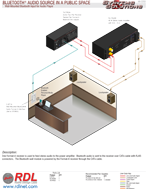
Description:
One Format-A receiver is used to feed stereo audio to the power amplifier. Bluetooth audio is sent to the receiver over CATx cable with RJ45 connectors. The Bluetooth wall module is powered by the Format-A receiver through the CATx cable.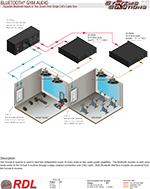
Description:
One Format-A receiver is used to feed two independent zones of mono audio to two audio power amplifiers. The Bluetooth receiver in each zone sends audio to the Format-A receiver through a daisy-chained connection over CATx cable. Both Bluetooth interface modules are powered from the Format-A receiver.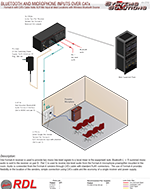
BLUETOOTH AND MICROPHONE INPUTS OVER CATx
Format-A with CATx Cable Adds XLR Mic Input at Ideal Locations with Wireless Bluetooth Source
AN-2251
Description:
One Format-A receiver is used to provide two mono line-level signals to a local mixer in the equipment rack. Bluetooth L + R summed mono audio is sent to the receiver on pair B. Pair C is used to receive line-level audio from the Format-A microphone preamplifier mounted in the room. Audio is connected from the Format-A senders through CATx cable with standard RJ45 connectors. The use of Format-A provides flexibility in the location of the senders, simple connection using CATx cable and the economy of a single receiver and power supply.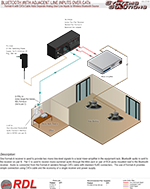
BLUETOOTH WITH ADJACENT LINE INPUTS OVER CATx
Format-A with CATx Cable Adds Separate Analog User Line Inputs to Wireless Bluetooth Source
AN-2250
Description:
One Format-A receiver is used to provide two mono line-level signals to a local mixer-amplifier in the equipment rack. Bluetooth audio is sent to the receiver on pair B. Pair C is used to receive mono-summed audio through the Mini-Jack or pair of RCA jacks mounted next to the Bluetooth receiver. Audio is connected from the Format-A senders through CATx cable with standard RJ45 connectors. The use of Format-A provides simple connection using CATx cable and the economy of a single receiver and power supply.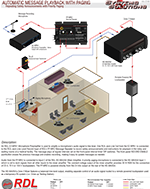
Description:
An RDL EZ-MPA1 Microphone Preamplifier is used to amplify a microphone’s audio signal to line-level. One RCA Jack Line Out from the EZ-MPA1 is connected to the RCA Jack Line-Level Record Input of RDL’s FP-MR2 Message Repeater to record safety announcements and instructions for playback in the lobby and waiting rooms at a medical facility. The message plays at regular intervals set on the front-panel interval timer DIP switches. The front-panel RECORD ENABLE pushbutton erases the previous message and enables recording, making it easy to update messages as needed.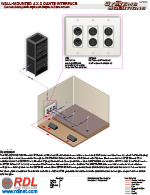
AN-2248
Description:
The RDL DD-BN40 Wall-Mounted Bi-Directional Mic/Line Dante Interface provides four front panel XLR audio inputs and two rear panel line-level analog outputs. Each output is connected through an AMS-XLRMA Selectable Mic/Line XLR Output with Phantom Block mounted in a D-D2 Decora Plate installed beside the DD-BN40 in a standard 3-gang electrical box. During installation, each AMS-XLRMA can be set to UNITY to feed a line-level input or to ATTEN (attenuate) to feed a microphone-level input on the powered monitor speaker. The AMS-XLRMA also provides circuitry to block phantom voltage from feeding back into the DD-BN40 output. Each DD-BN40 XLR input provides three switches that are set from the front of the unit before the cover plate is installed. One switch enables or disables P48 phantom; the second switch selects the mic or line gain range; the third switch sets the gain.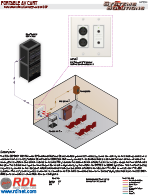
Description:
The RDL DD-BN31 Wall-Mounted Bi-Directional Mic/Line Dante Interface provides all necessary audio connectivity for this meeting room and is networked with a centrally-located Dante-enabled DSP. Each XLR input provides three switches that are set from the front of the unit before the cover plate is installed. One switch enables or disables P48 phantom; the second switch selects the mic or line gain range; the third switch sets the gain. The 3.5mm Line Input and Line Output can be set independently by the installer for STEREO or MONO operation. Two line-level analog outputs are provided on the rear-panel detachable terminal block and are switch selectable for balanced (+4 dBu) or unbalanced (-10 dBV) operation. The rear-panel outputs are intended for connection to RDL AMS connectors mounted in Decora-style plates that match the DD-BN31. AMS audio connectors include RCA, Mini and XLR jacks.
USE A CATX HOME RUN FOR EACH FORMAT-A SOURCE
Power Inserter / Signal Breakout Module Permits Home Run Cabling to Dante™ Network
AN-2233
Description:
In this Format-A installation, it was not practical to loop CATx cable between the senders in different rooms. A home run from each microphone sender was pulled to the equipment rack. The TX-TP4PW Power Inserter / Signal Breakout module is used to connect Pairs A, B and C to a single cable run and to insert power. The sources sent on pairs A, B and C are all present on the cable that connects the TX-TP4PW to the RJ45 input of the RU-FN format-A to Network Interface. Each of the three sources will be transmitted on a separate Dante channel. All the Format-A modules are powered by the external supply connected to the TX-TP4PW.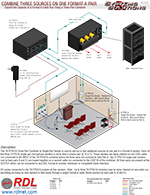
COMBINE THREE SOURCES ON ONE FORMAT-A PAIR
Expand the Capacity of a Format-A Cable Run Using a Three-Pair Combiner
AN-2232
Description:
The TX-TPSA1A Three-Pair Combiner to Single-Pair Sender is used to add up to two additional sources to one pair in a Format-A system. Each of the three D-TPS1A single-pair microphone senders is set to feed a unique pair (A, B or C). These senders are daisy chained on one CATx cable run connected to the INPUT of the TX-TPSA1A combiner where the three pairs are summed to feed Pair A. Two D-TPSL1A single-pair senders (set to feed pairs B and C) are looped together on a second cable run connected to the LOOP IN of the combiner. All three pairs are present at the OUTPUT which can be connected to any RDL Format-A receiver, distributor or compatible Dante interface. DC power connected to the TX-TPSA1A powers all five senders. Note: Up to three TX-TPSA1A modules may be daisy chained on one cable run, permitting as many as nine senders to feed audio through a single Format-A cable (three sources on each pair A, B and C)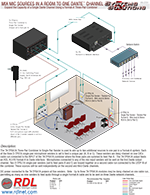
MIX MIC SOURCES IN A ROOM TO ONE DANTE™ CHANNEL
Expand the Capacity of a Single Dante Channel Using a Format-A Three-Pair Combiner
AN-2231
Description:
The TX-TPSA1A Three-Pair Combiner to Single-Pair Sender is used to add up to two additional sources to one pair in a Format-A system. Each of the three D-TPS1A single-pair microphone senders is set to feed a unique pair (A, B or C). These senders are daisy chained on one CATx cable run connected to the INPUT of the TX-TPSA1A combiner where the three pairs are summed to feed Pair A. The TX-TPSA1A output feeds an RDL RU-FN Format-A to Dante Interface. Microphones connected to any of the mic-input senders will be sent on the first Dante output channel. Two D-TPSL1A single-pair senders (set to feed pairs B and C) are looped together on a second cable run connected to the LOOP IN of the combiner. These sources will be sent independently on the second and third Dante channels. DC power connected to the TX-TPSA1A powers all five senders. Note: Up to three TX-TPSA1A modules may be daisy chained on one cable run, permitting as many as nine senders to feed audio through a single Format-A cable and to be sent on three Dante network channels.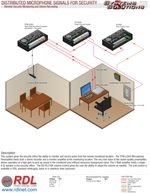
Description:
This system gives the security office the ability to monitor and record audio from the remote monitored location. The STM-LDA3 Microphone Preamplifier feeds both a stereo recorder and a monitor amplifier at the monitoring location. The very low noise of the studio-quality preamplifier allows operation at a high gain to pick up sound in the monitored area without excessive background noise. The 2 Watt amplifier feeds a single 8 Ω speaker in the security office. The DS-RLC10K volume control gives the user the ability to adjust the volume as needed. The wall control is available in RDL standard white/gray, black or in stainless steel (pictured).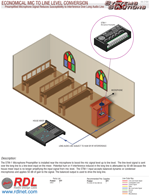
ECONOMICAL MIC TO LINE LEVEL CONVERSION
Preamplified Microphone Signal Reduces Susceptibility to Interference Over Long Audio Line
AN-2184
Description:
The STM-1 Microphone Preamplifier is installed near the microphone to boost the mic signal level up to line level. The line-level signal is sent over the long line to a line-level input on the mixer. Potential hum or rf interference induced in the long line is attenuated by 50 dB because the house mixer input is no longer amplifying the input signal from mic level. The STM-1 input accepts balanced dynamic or condenser microphones and applies 50 dB of gain to the signal. The balanced output is used to drive the long line.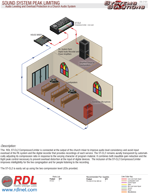
Description:
The RDL ST-CL2 Compressor/Limiter is connected at the output of the church mixer to improve audio level consistency and avoid input overload of the PA system and the digital recorder that provides recordings of each service. The ST-CL2 remains aurally transparent by automatically adjusting its compression ratio in response to the varying character of program material. It combines both inaudible gain reduction and the tight peak control necessary to prevent overload distortion at the input of digital devices. The inclusion of the ST-CL2 Compressor/Limiter improves intelligibility for the live congregation and for people listening to the recording. The ST-CL2 is easily set up using the two compression level LEDs provided.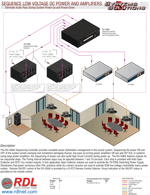
SEQUENCE LOW VOLTAGE DC POWER AND AMPLIFIERS
Eliminate Audio Pops During System Power-Up and Power-Down
AN-2173
Description:
The RU-SQ6A Sequencing Controller provides complete power distribution management in this sound system. Sequencing the power ON and OFF of the system avoids annoying and sometimes damaging thumps and pops by turning power amplifiers ON last and OFF first. In systems using large power amplifiers, the sequencing of power can also avoid high inrush currents during power up. The RU-SQ6A features outputs for six sequential steps. The Timing Interval between steps may be adjusted between 1 and 10 seconds. Each step is provided with both Open Collector and SPST dry contact outputs. In this application Open Collector outputs are used to activate the TX-PD8X Switching Power Supply Distributors that power numerous other RDL products while dry contact closures are used to activate OEM low voltage controllable mains power outlets. Remote ON/OFF control of the RU-SQ6A is provided by a D-RT2 Remote Control Selector. Visual indication of the ON/OFF status is provided on the remote control.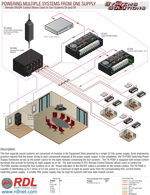
POWERING MULTIPLE SYSTEMS FROM ONE SUPPLY
Remote ON/OFF Control Allows Users to Turn Systems On and Off
AN-2172
Description:
The four separate sound systems are comprised of modules in the Equipment Rack powered by a single 24 Vdc power supply. Good engineering practice requires that the power wiring to each component originate at the power supply output. In this installation, the TX-PD8X Switching Power Supply Distributor serves as the power source for the eight modules comprising the four systems. The TX-PD8X is equipped with remote control terminals that provide for turning its eight outputs on or off. The wall-mounted D-RT2 Remote Control Selector allows users to control the TX-PD8X, thereby turning the four systems on or off. Visual indication of the ON/OFF status is provided on the remote control. The TX-PD8X is capable of distributing up to 2 Amps of 24 Vdc power to a maximum of eight dc power jacks from the corresponding RDL current-limited switching power supply. A smaller RDL power supply may be used for systems with less total module current.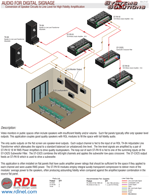
AUDIO FOR DIGITAL SIGNAGE
Conversion of Speaker Circuits to Line Level for High Fidelity Amplification
AN-2147
Description:
Video monitors in public spaces often include speakers with insufficient fidelity and/or volume. Such flat panels typically offer only speaker level outputs. This application couples good quality speakers with RDL modules to fill the space with full fidelity audio. The only audio outputs on the flat screen are speaker-level outputs. Each output channel is fed to the input of an RDL TX-8A Adjustable Line Transformer which attenuates the signal to a standard balanced (or unbalanced) line level. The line-level signals are amplified by a pair of ST-PA18 18 W RMS Power Amplifiers to drive quality loudspeakers. The loop out of each ST-PA18 is fed to one of the summing inputs on the ST-CX2S Subwoofer Filter. The ST-CX2S combines the left/right channels and applies the subwoofer low-pass crossover. The ST-CX2S output feeds an ST-PA18 which is used to drive a subwoofer. This application is often installed on flat panels that have audio amplifier power ratings that should be sufficient for the space if they applied to each channel and were usable RMS power. The ST-PA18 modules employ integral aurally transparent compression to deliver more of the modules’ average power to the speakers, often producing astounding fidelity when compared against the amplifier/speaker combination in the source flat panel.
DISTRIBUTED VGA VIDEO TO MULTIPLE MONITORS
Hotel Provides Multiple Video Monitors that Display Daily Schedule of Events
AN-2090
Description:
The daily Calendar of Events listing at this hotel is generated from an office computer. An RDL EZ-VM14 distributes the VGA signal of the schedule display to three monitors located near the entrances of the hotel meeting rooms. The wide bandwidth of the EZ-VM14 insures that the same high resolution image seen at the local monitor is seen at each hotel monitor.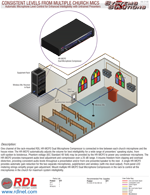
CONSISTENT LEVELS FROM MULTIPLE CHURCH MICS
Automatic Microphone Level Control for Enhanced Intelligibility with Untrained Presenters
AN-2149
Description:
One channel of the rack-mounted RDL HR-MCP2 Dual Microphone Compressor is connected in-line between each church microphone and the house mixer. The HR-MCP2 automatically adjusts the volume for best intelligibility for a wide range of presenters’ speaking styles, from soft-spoken to boisterous. Phantom voltage (IEC Standard 48 Volt) may be provided by the HR-MCP2 to power any condenser microphone. The HR-MCP2 provides transparent audio level adjustment and compression over a 25 dB range. It insures freedom from clipping and overload distortion, providing consistent audio levels throughout a presentation and/or from one presenter/speaker to the next. A single HR-MCP2 provides automatic gain reduction for the two separate microphones, pulpit/lectern and wireless (with mic-level output). Front-panel LED metering strings simplify proper gain adjustment. Mount multiple HR-MCP2 Dual Microphone Compressors in the rack to control all the microphones in the church for maximum system intelligibility.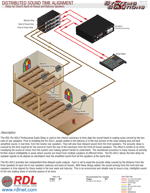
Description:
The RDL RU-ADL2 Professional Audio Delay is used in this church sanctuary to time align the sound heard in seating areas served by the two sets of rear speakers. Prior to installing the RU-ADL2, people seated in the balcony or in the rear portion of the main seating area will hear amplified sound, in real time, from the nearby rear speakers. They will also hear delayed sound from the front speakers. The acoustic delay is caused by the time required for the sound to reach the rear of the sanctuary from the front-of-house speakers. The effect is similar to an echo, muddying the sound of music from the system and making speech harder to understand. The reverberant acoustics in many houses of worship further reduce intelligibility in areas where sounds are heard from multiple speakers at different times. The RU-ADL2 allows the time delay for speaker signals to be aligned so worshipers hear the amplified sound from all the speakers at the same time. The RU-ADL2 provides two independent time-delayed audio outputs. Each is set to equal the acoustic delay caused by the distance from the front speakers to each set of rear speakers (balcony and back-of-house). With these delays added, the sound arriving from the front and rear speakers is time aligned for those seated in the rear seats and balcony. This is an economical and reliable way to insure crisp, intelligible sound in the rear seating areas of worship spaces of all sizes.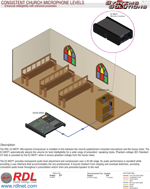
Description:
The RDL EZ-MCP1 Microphone Compressor is installed in-line between the church pulpit/lectern-mounted microphone and the house mixer. The EZ-MCP1 automatically adjusts the volume for best intelligibility for a wide range of presenters’ speaking styles. Phantom voltage (IEC Standard 24 Volt) is provided by the EZ-MCP1 when it senses phantom voltage from the house mixer. The EZ-MCP1 provides transparent audio level adjustment and compression over a 30 dB range. Its audio performance is excellent while providing a user interface that accommodates the non-professional. It insures freedom from clipping and overload distortion, providing consistent audio levels throughout a presentation and/or from one presenter/speaker to the next.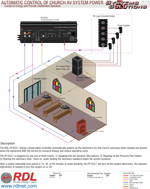
AN-2106
Description:
The RDL FP-ECC1 Energy Conservation Controller automatically powers up the electronics for this church sanctuary when needed and powers down the equipment after the service to conserve energy and reduce operating costs. The FP-ECC1 is triggered by any one of three events: 1] Speaking into the Dynamic Microphone; 2] Stepping on the Pressure Pad Switch; 3] Opening the sanctuary door. Once on, audio feeding the sanctuary speakers keeps the system powered. After a switch-selectable time period of 15, 30, or 60 minutes of audio inactivity, the FP-ECC1 will turn off the system electronics. No operator intervention is needed to turn the system on or off.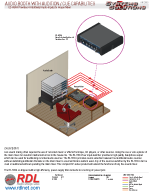
AUDIO BOOTH WITH AUDITION / CUE CAPABILITIES
EZ-HSX4 Provides 4 Additional Audio Inputs to House Mixer
AN-2005
Description:
Live sound mixing often requires the use of recorded music or effects from tape, CD players, or other sources. Using the cue or solo options of the main mixer can result in inadvertent errors in the house mix. The EZ-HSX4 four input switcher provides a high quality headphone output which can be used for auditioning recorded audio sources. The EZ-HSX4 provides source selection between four additional audio sources without dedicating additional channels on the main mixer to sources that are seldom used. Any of the sources switched by the EZ-HSX4 can be cued or auditioned without operating the main mixer. This compact EZ series product will extend the functions of any live sound mixer.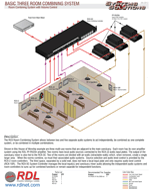
Description:
The RCX Room Combining System allows between two and five separate audio systems to act independently, be combined as one complete system, or be combined in multiple combinations. Shown in this House of Worship example are three multi-use rooms that are adjacent to the main sanctuary. Each room has its own amplifier system using the RDL FP-PA20A amplifier. Two rooms have local audio sources connected to the RCX-J3 audio input plates. The output of the sanctuary mixer is also fed to the RCX-5C. Two of the rooms are divided with air-walls (retractable walls) which, when removed, create a single larger area. When the rooms combine, so must their associated audio systems. Source selection and audio level control is provided by the RCX-2 room controllers. The third space, separated by a solid wall, does not have a local input plate and only requires audio level control (RCX-10R). The RCX-5C System Controller manages the local input(s) and sanctuary mixer audio allowing the independent audio systems and room controllers to sync up for combined functions or remain separate for independent functions.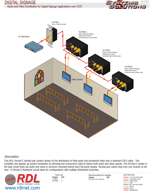
Description:
This RDL Format-C twisted pair system allows for the distribution of both audio and composite video over a standard CAT5 cable. This simplifies and speeds up system installation by allowing one economical cable to deliver both audio and video signals. The Format-C sender in the data closet feeds the audio and video to receivers mounted behind each flat panel display. Twisted pair cables loop from one receiver to the next. A Format-C distributor would allow for configurations with multiple distribution branches.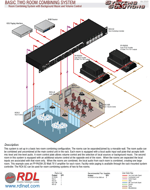
AN-2059
Description:
This system is set up in a basic two room combining configuration. The rooms can be separated/joined by a movable wall. The room audio can be combined and uncombined at the main control unit in the rack. Each room is equipped with a local audio input wall plate that accepts both mic-level and line-level audio. A room control plate allows volume control and the selection of local sources or background music. The second room in this system is equipped with an additional volume control at the opposite end of the room. When the rooms are separated the local inputs are associated with that room only. When the rooms are combined, the local audio from each room is combined, creating one large room. This example uses an FP-PA20A 20 Watt 70 V amplifier for each room. Facility-wide paging is available through the rack mounted system controller. The RCX-5C can be used for room combining systems of two to five rooms.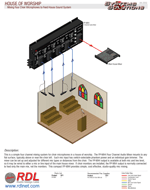
Description:
This is a simple four channel mixing system for choir microphones in a house of worship. The FP-MX4 Four Channel Audio Mixer mounts to any flat surface, typically above or near the choir loft. Each mic input has switch-selectable phantom power and an individual gain trimmer. The mixer can be set up and adjusted for different mic types or distances from the choir. The FP-MX4 output is available at both mic and line level, so it may be wired to either a mic or line input of the main house mixer. If choir monitors are installed, the FP-MX4 output is normally connected to feed only the main mix, not the monitors. This compact FP-MX4 provides simple, cost effective, studio-quality mic mixing.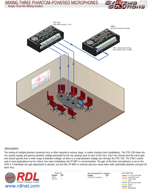
Description:
The mixing of multiple phantom-powered mics is often required in various stage or public meeting room installations. The STD-150 mixes the mic signals equally and passes phantom voltage generated by the mic preamp back to each of the mics. Each mic should have the same gain and should operate from a wide range of phantom voltage, as there is a small phantom voltage loss through the STD-150. The STM-3 works well in most applications but for critical, low noise installations the FP-MP1 is recommended. The gain of the three microphones is set on the STM-3. If individual mic gain adjustment is desired, use the RDL FP-MX4 (4 channel ultra-low-noise mixer with switchable phantom and gain for each mic).